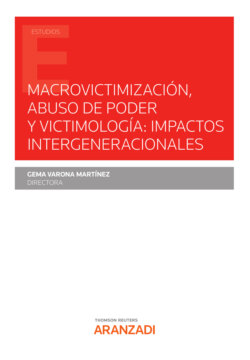Читать книгу Macrovictimización, abuso de poder y victimología: impactos intergeneracionales - Gema Varona Martínez - Страница 10
На сайте Литреса книга снята с продажи.
I. Introduction
ОглавлениеAlthough Europe is facing domestic political terrorism since the late 1950s, it is only since the rise of jihadism and especially the New York attacks of September 11, 2001 that the fight against terrorism has become a main concern of European policies. While victims of terrorism remained for a long time neglected by these policies focusing on the prevention and repression of terrorism, their needs and rights slowly start to be considered by European institutions. While no binding instrument is specifically dedicated to them, more and more instruments relating to the fight against terrorism include binding provisions to promote the rights of victims of terrorism. Besides, the Council of Europe and the European Union (“EU”) have adopted several texts of soft law aimed at improving assistance, support and protection of victims of terrorism.
This paper will examine the main types of rights and benefits provided by these texts to increase support and reparation of direct but also of indirect/vicarious victims of terrorism considering that, according to many authors, these vicarious victims would constitute the main or ultimate target of the terrorist attacks2. Indeed, terrorism victimization extends way beyond the people who are directly affected by the attacks, their relatives or the persons who suffered damage because of their intervention to help the direct victims on the site of the attack3.
Considering the ideological purpose of terrorism, terrorist acts are specifically designed to spread terror and provoke further damage within a much larger group than the direct victims4. As a result, many members of this targeted group may suffer from serious damage resulting from the attack: psychological disorder (intense feeling of fear or terror, post-traumatic stress disorder, depression, etc.), economic and financial loss (especially for the people working in the area, the tourism sector, the –foreign– investment or the transport sector), material damage (e.g. airport infrastructure), etc.5.
In addition to this vicarious victimization within the target group, terrorist provocation strategy tends to generate new victims because of the political and social reactions to the attacks. At political level, the strengthening of counter-terrorism measures has led to numerous human rights violations (torture, violation of the right to fair trial, of the presumption of innocence, etc.)6, as illustrated by the conditions of detention in Guantanamo7. The “war against terror” has also encouraged the use of armed force (in Afghanistan, Pakistan, Iraq, Syria, etc.), which has caused the dead of countless civilians (the victims of the fight against terrorism)8.
Regarding social reactions, terrorist attacks have the effect of fostering a climate of hatred and mistrust against members of the group associated with the terrorists (in the case of jihadism, the Arab-Muslim community)9. In addition to increased islamophobia, racism, stigmatization and discrimination, this phenomenon of “vicarious retribution”10 can lead to violent reactions, as illustrated by the terrorist attacks of Christchurch of March 15, 2019 in New Zeeland where 50 Muslims were killed.
In view of the above, many authors consider that the main feature and impact of terrorism relates to this vicarious victimization11. Nevertheless, it seems that these numerous vicarious victims are not included in the legal definitions of victims of terrorism adopted by the Council of Europe12 and the EU13, which tend to limit the status of victims to direct victims and, to a lesser extent, to their relatives.
On the contrary, vicarious victims seem to be recognized at international level. The “Framework principles for securing the human rights of victims of terrorism”14 elaborated by the UN Special Rapporteur on the promotion and protection of human rights and fundamental freedoms while countering terrorism define the victims of terrorism through a typology distinguishing four major categories of victims: Direct victims of terrorism (natural persons who have been killed or have suffered serious physical or psychological injury as the result of an act of terrorism) (i); Secondary victims of terrorism (immediate family or dependants of the direct victim) (ii); Indirect victims of terrorism (individuals who have suffered serious physical or psychological injury as the indirect result of an act of terrorism, including members of the public who have been killed or injured in consequence of antiterrorism measures, eyewitnesses who have sustained serious psychological harm as the result of witnessing a violent terrorist incident or its immediate aftermath, individuals who have been subjected to potentially lethal force by a public authority after being mistakenly identified as a suspected terrorist; rescue workers who suffer serious physical or psychological harm as the result of taking part in emergency relief) (iii); Potential victims of terrorism (the principal beneficiaries of the State’s positive obligations under article 6 of the International Covenant on Civil and Political Rights).
It should also be noted that, even though they are not included in the European definitions of victims of terrorism, the vicarious victims are recognized by a series of texts adopted within the Council of Europe and the European Union, which stress the damages they may suffer as an indirect result of terrorist attacks. For instance, the European institutions recognize that terrorism provokes significant indirect victimization within the targeted group (stressing that terrorist attacks may have serious psychological and financial consequences on its members)15 but also among the group associated to the authors of terrorist attacks (recognizing that terrorism and the fight against terrorism have generated a climate of hatred and mistrust towards the Arab-Muslim community, who is subject to increased discrimination, stigmatization, exclusion and vicarious retribution by western populations)16. The victims of the fight against terrorism are also recognized by a multitude of instruments that call on Member States to protect their rights and, as the case may be, to guarantee them effective remedies and reparation17.
This paper will thus examine the main types of rights and obligations provided for both the direct and indirect victims of terrorism, by distinguishing the provisions adopted by the Council of Europe (1) and the UE (2).
